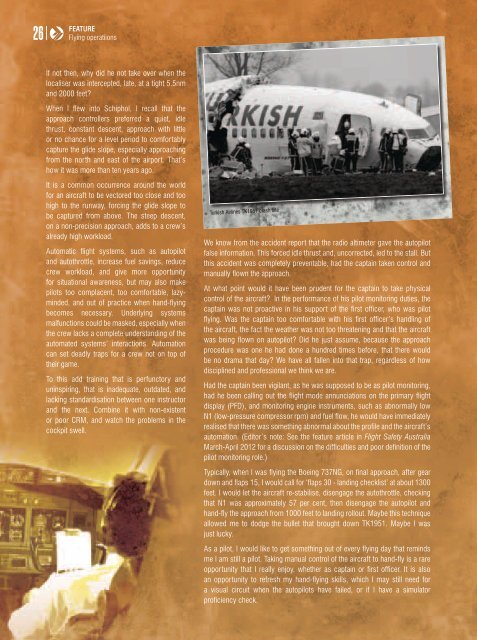jul-aug2012
Create successful ePaper yourself
Turn your PDF publications into a flip-book with our unique Google optimized e-Paper software.
26<br />
FEATURE<br />
Flying operatiions<br />
If not then, why did he not take over when the<br />
localiser was intercepted, late, at a tight 5.5nm<br />
and 2000 feet?<br />
When I flew into Schiphol, I recall that the<br />
approach controllers preferred a quiet, idle<br />
thrust, constant descent, approach with little<br />
or no chance for a level period to comfortably<br />
capture the glide slope, especially approaching<br />
from the north and east of the airport. That’s<br />
how it was more than ten years ago.<br />
It is a common occurrence around the world<br />
for an aircraft to be vectored too close and too<br />
high to the runway, forcing the glide slope to<br />
be captured from above. The steep descent,<br />
on a non-precision approach, adds to a crew’s<br />
already high workload.<br />
Automatic flight systems, such as autopilot<br />
and autothrottle, increase fuel savings, reduce<br />
crew workload, and give more opportunity<br />
for situational awareness, but may also make<br />
pilots too complacent, too comfortable, lazyminded,<br />
and out of practice when hand-flying<br />
becomes necessary. Underlying systems<br />
malfunctions could be masked, especially when<br />
the crew lacks a complete understanding of the<br />
automated systems’ interactions. Automation<br />
can set deadly traps for a crew not on top of<br />
their game.<br />
To this add training that is perfunctory and<br />
uninspiring, that is inadequate, outdated, and<br />
lacking standardisation between one instructor<br />
and the next. Combine it with non-existent<br />
or poor CRM, and watch the problems in the<br />
cockpit swell.<br />
Turkish Airlines TK1951 crash site<br />
We know from the accident report that the radio altimeter gave the autopilot<br />
false information. This forced idle thrust and, uncorrected, led to the stall. But<br />
this accident was completely preventable, had the captain taken control and<br />
manually flown the approach.<br />
At what point would it have been prudent for the captain to take physical<br />
control of the aircraft? In the performance of his pilot monitoring duties, the<br />
captain was not proactive in his support of the first officer, who was pilot<br />
flying. Was the captain too comfortable with his first officer’s handling of<br />
the aircraft, the fact the weather was not too threatening and that the aircraft<br />
was being flown on autopilot? Did he just assume, because the approach<br />
procedure was one he had done a hundred times before, that there would<br />
be no drama that day? We have all fallen into that trap, regardless of how<br />
disciplined and professional we think we are.<br />
Had the captain been vigilant, as he was supposed to be as pilot monitoring,<br />
had he been calling out the flight mode annunciations on the primary flight<br />
display (PFD), and monitoring engine instruments, such as abnormally low<br />
N1 (low-pressure compressor rpm) and fuel flow, he would have immediately<br />
realised that there was something abnormal about the profile and the aircraft’s<br />
automation. (Editor’s note: See the feature article in Flight Safety Australia<br />
March-April 2012 for a discussion on the difficulties and poor definition of the<br />
pilot monitoring role.)<br />
Typically, when I was flying the Boeing 737NG, on final approach, after gear<br />
down and flaps 15, I would call for ‘flaps 30 - landing checklist’ at about 1300<br />
feet. I would let the aircraft re-stabilise, disengage the autothrottle, checking<br />
that N1 was approximately 57 per cent, then disengage the autopilot and<br />
hand-fly the approach from 1000 feet to landing rollout. Maybe this technique<br />
allowed me to dodge the bullet that brought down TK1951. Maybe I was<br />
just lucky.<br />
As a pilot, I would like to get something out of every flying day that reminds<br />
me I am still a pilot. Taking manual control of the aircraft to hand-fly is a rare<br />
opportunity that I really enjoy, whether as captain or first officer. It is also<br />
an opportunity to refresh my hand-flying skills, which I may still need for<br />
a visual circuit when the autopilots have failed, or if I have a simulator<br />
proficiency check.

















